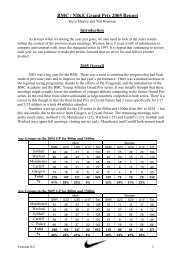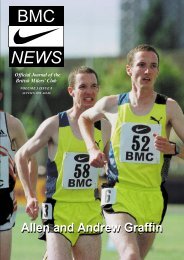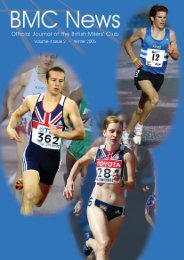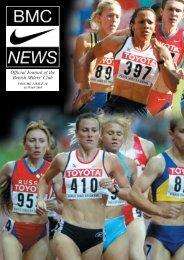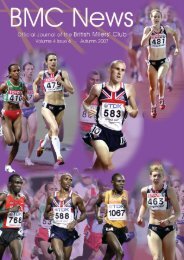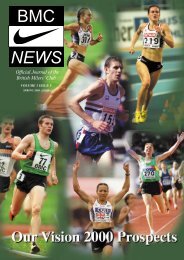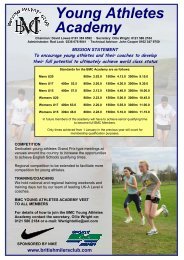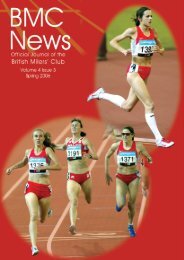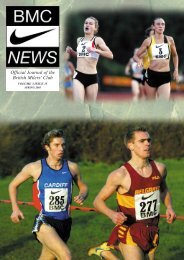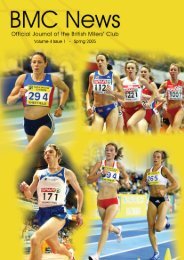You also want an ePaper? Increase the reach of your titles
YUMPU automatically turns print PDFs into web optimized ePapers that Google loves.
BMC April <strong>1999</strong> 6/6/99 9:06 pm Page 8Dave Moorcroft - analysis of a championtions which David experienced during 1966-82 and the corresponding number of days inwhich no training was performed during themajor seasons January-mid April, and midApril-mid September and mid September toend December. It is interesting to note thatDavid experienced an average of 46 competitionsper year, or almost one per week, duringthe years 1966-73 when he was aged 13-20years. It was this relatively high number ofcompetitions which enabled David to learn thecraft of racing and to develop and focus hiscompetitive mind when it mattered. From theage of 15 years onward, approximately 50 percent of these competitions were run duringsummer months mid April-mid September.Many of these low key local meetings andleague matches or school competitions, whichwere utilised as competitive training sessions,were won by David.In terms of the number of days with notraining, Fig 4 exhibits a number of interestingfeatures. During the period 1966-69 inclusive,most of these ÔlostÕ days were deliberatelydesigned into the training schedule of theyoung Moorcroft. From 1970 onward thegreater number of training days proposed byJohn Anderson are immediately obvious.Similarly, serious losses of training due toinjury and illness, as in 1977, are alsoapparent.PeriodisationDuring the period 1964-May 69 as has beenpreviously mentioned DavidÕs main focus ofattention was the major Area and Nationalschools/clubs cross0country Championships.From may 1969 John reorientated DavidÕsmajor aims towards the national Schools and<strong>Club</strong>s track Championships held during theSummer months. Winter cross-countryChampionships were viewed more as a guideto Winter endurance progress than as a majoraim. Since John AndersonÕs training methodsalso involved elements of ãqualityÕ workduring these Winter months David also oftencompeted indoors and outdoors in Australiaand New Zealand, once again the indoorseason was never seen as a major aim.As a senior athlete therefore DavidMoorcroft could be seen in principle to adopta single periodised year with his main aim tobe at a peak of fitness for the National and anyother major Summer track Championshipswhich may occur. Each year, apart from thosewhere a Commonwealth Championshipoccurred during a <strong>British</strong> Winter, could be splitinto 5 major periods. These are given below inapproximate terms and would be adjusted totake account of previous injuries, andassociated training loss, and the dates of majorChampionships.Period 1November-December (8 weeks) EnduranceDevelopmentEach year after a rest and recovery periodduring late September and October Davidwould gradually increase weekly trainingmileages from early November to a maximumof 70-80mls by late December. This wouldusually consist of steady running, 1 or 2 fartleksessions per week and between 2 and 3 lowkey races during this 8 week period. Davidwas at no stage approaching maximum weeklymileages during this period and consequentlyvery few rest days were required.Period 2January-March (13 weeks) EnduranceConsolidationDuring this period of Wintertraining maximum weeklymileages would be increased to therange of 90-100mls. This level oftraining was usually maintainedfor blocks of 3-5 weeks beforetaking a 1 week recovery/rejuvenationbreak. During this easierweek training mileages would bereduced to the range of 50-70mlsto meet DavidÕs specific recoveryrequirements at that time. A typicaltraining week for this period ofapprox. 100mls is given in table 3.It is immediately obvious from thetable that DavidÕs training duringJan-March is highly orientatedtowards the development of asound aerobic/endurance basewith the bulk of his mileagecovered at sub-maximal aerobicpace. Over the years David andJohn experimented with the paceof the evening steady runs.increasing the pace and thereforethe fatigue levels meant reducingthe distance run. Reducing thepace did allow greater mileages to8BMC News : <strong>Spring</strong> <strong>1999</strong>



